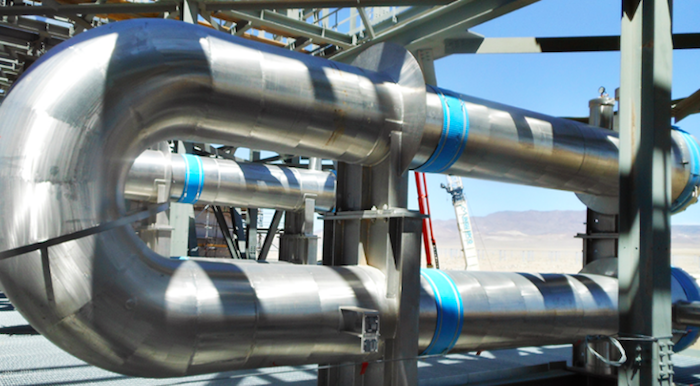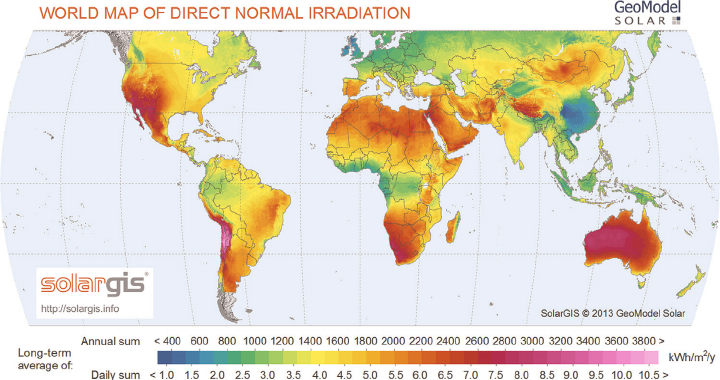Like natural gas, CSP can provide power grid stability

Initially, CSP, the solar thermal form of energy was perceived as competing with solar PV, but actually it competes with natural gas to stabilize the grid, by generating solar power from a thermal energy power block
Concentrated Solar Power (CSP) is a dispatchable form of solar thermal energy
CSP power plants, like photovoltaic (PV) solar farms, are 100% solar and have stable prices, as both sell their projected generation over a 25-30 year period in a contract at a preset price per kWh.
But, although CSP is like PV in those ways, it operates like a conventional thermal power plant. In particular, CSP competes with natural gas by providing dispatchable power to the grid.
Here’s how it works:
Natural gas, coal, or nuclear power plants run on thermal energy to make electricity. They continually burn fuel to produce heat which is used to run a turbine and generate electricity.
CSP also runs on thermal energy to generate electricity. (How CSP works) But instead of burning fuel to generate each new hour of electricity, CSP harvests sunlight as heat that it stores and uses like other thermal power plants to run a turbine and generate electricity.
Because of this ability to make and store solar energy thermally, CSP can deliver flexibly like a natural gas power plant. (Coal and nuclear are less flexible) So CSP is solar power that can be dispatched in the evening, before sunrise, or at whatever time the regional grid needs power. Typical CSP plants include 10 hours of storage that can be tapped daily in whole or in part.
Batteries are also crucial to a renewable grid
Batteries can also be sited on the grid or included with solar farms to make PV dispatchable. In addition, batteries can inject power instantaneously as needed. Batteries are more costly than thermal energy storage in a CSP plant for discharging longer than 2-4 hours. But the instant-on power of batteries is also critical to the fully renewable grid of the future.
As a thermal power plant, CSP provides the same grid stabilization services as natural gas.
-
- Spinning Reserve: The generator in a thermal power block is rotating at a speed that will produce power at precisely the same frequency as the grid power frequency.
- Voltage Support: Thermal power plants can help maintain grid stability by providing reactive power support. Reactive power is required to regulate voltage levels and keep them within acceptable limits. Thermal power plants help maintain grid voltage stability by injecting or absorbing reactive power.
- Load Following: Thermal power plants can adjust their output based on daily load fluctuations. They can ramp up or down their generation to match the changing demand, ensuring a balance between electricity supply and consumption.
- Voltage Control: Thermal power plants can actively regulate grid voltage by adjusting their reactive power output. This helps maintain the desired voltage levels at various points in the grid and ensures the quality and reliability of the electricity supply.
- Grid Stability and Resilience: Thermal power plants provide grid stability by acting as a reliable source of electricity generation. They contribute to the overall resilience of the grid by providing a stable and controllable source of power that can support the integration of intermittent renewable energy sources.
This makes CSP a technology that can advance the 100% renewable energy grid because it can actively replace fossil energy as a backup for intermittent sources. CSP plays a role in a cleaner new grid with the other renewables and batteries.
CSP advantages over natural gas
As a renewable fill-in source that helps to keep the grid stable, CSP has several advantages over natural gas:
1. Natural gas must be stored in vast underground caverns near load centers like cities. As a result, leaks like the Aliso Canyon leak are an ongoing danger.
2. Natural gas prices are unpredictable, while CSP prices are set in 25-year contracts.
3. Natural gas methane leaks during drilling and transporting immediately impact our climate, while CSP is solar energy.
However, as a solar technology, CSP requires sun to make heat. The regions of the world where it is most suitable have 1800 kWh/sm/yr or more of DNI, such as the US Southwest, Chile, Australia, the Middle East, Africa, China, India, and Southern Europe.















































